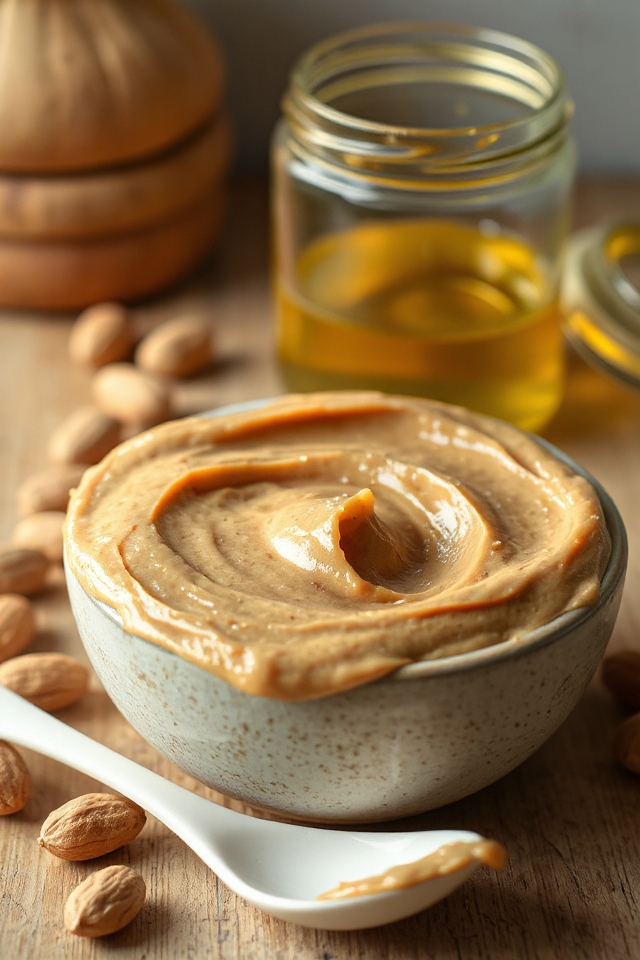Why You’ll Love This Homemade Peanut Butter Recipe
If you’ve ever tasted homemade peanut butter, you know just how much better it’s than store-bought versions. The creamy texture and rich flavor are simply unbeatable.
I love how I can customize it to my liking—whether it’s adding a touch of salt or a splash of oil for smoothness. Plus, there’s something satisfying about making it myself. It’s fresh, free from preservatives, and I know exactly what’s in it.
Each spoonful brings a sense of accomplishment. Whether you spread it on toast or dip apples, this homemade peanut butter will elevate any snack. Trust me, you’ll be hooked!
Ingredients of Homemade Peanut Butter
When it comes to making your own peanut butter, gathering the right ingredients is the first step toward that creamy, dreamy goodness. It’s surprisingly simple and you probably have most of these items already hanging out in your kitchen.
Plus, making it yourself means you can tweak it to fit your taste perfectly—no more weird preservatives or mystery ingredients. So, let’s get to it!
Here’s what you’ll need to whip up this fabulous homemade peanut butter:
- 2 cups of roasted peanuts
- 1 to 3 tablespoons of oil (any kind you prefer)
- A pinch of salt (if you’re using unsalted peanuts)
Now, while these are the basic ingredients, you might be wondering about a few things. For starters, the type of peanuts you use can really change the game.
I’ve tried it with both salted and unsalted peanuts, and while salted is great for a savory kick, unsalted gives you more control over the flavor.
And then there’s the oil—don’t stress too much about which one to choose. Whether you go with peanut oil for that extra peanuty punch, or something lighter like canola oil, it’s all good!
Just remember, if you’re feeling adventurous, you can also toss in some honey or cinnamon for a little sweetness. Who knew peanut butter could be so versatile?
How to Make Homemade Peanut Butter

Once they resemble tiny beads, it’s time to add the oil. You can use 1 to 3 tablespoons of any oil—I usually start with 1 tablespoon and add more if I want a creamier texture.
Pour it in and blend away! You may need to stop and scrape down the sides of the bowl with a spoon a couple of times. Don’t panic if it forms a ball; that’s just part of the process.
After a few minutes, it’ll start to whip into that velvety smoothness we all love. Just keep processing until you reach your desired consistency. If you like it chunky, you can even save some whole peanuts to mix in at the end.
And voilà, you’ve got yourself some homemade peanut butter! Store it in the fridge or at room temperature, but let’s be honest, it probably won’t last long enough to need any special storage.
Homemade Peanut Butter Substitutions & Variations
While I love a classic homemade peanut butter, experimenting with substitutions and variations can take it to a whole new level.
For a unique twist, try adding honey or maple syrup for sweetness, or incorporate cocoa powder for a chocolatey flavor. If you’re feeling adventurous, mix in spices like cinnamon or cayenne for a kick.
For nut-free options, sunflower seeds can be blended into a delicious spread. You can also swap in different nuts, like almonds or cashews, for a fresh taste.
Each variation brings its own charm, so don’t hesitate to get creative in the kitchen!
What to Serve with Homemade Peanut Butter
After experimenting with delicious substitutions and variations for homemade peanut butter, it’s time to think about what to serve it with.
I love spreading it on whole-grain toast for a hearty breakfast. It’s also fantastic as a dip for apple slices or banana chunks—talk about a tasty snack!
If I’m feeling adventurous, I’ll mix it into oatmeal or yogurt for added creaminess and flavor.
For a quick treat, I enjoy peanut butter on rice cakes topped with honey.
It even works well in smoothies, adding that rich, nutty goodness.
Trust me; you can’t go wrong with these options!
Additional Tips & Notes
When making homemade peanut butter, it’s essential to keep a few tips in mind to guarantee the best results.
First, choose quality roasted peanuts for richer flavor. If you want a creamier consistency, try adding more oil gradually.
Don’t rush the grinding process; allow the food processor to do its job until it reaches smoothness. If it seems too thick, just add a bit more oil.
Finally, experiment with flavors! A dash of honey or cinnamon can elevate your peanut butter.
Store it in an airtight container for freshness, and enjoy your delicious creation in various ways!